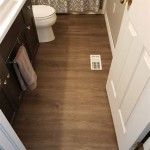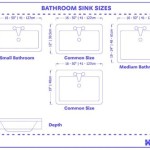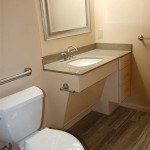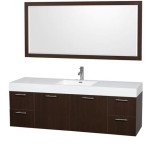Curved Bathroom Sink Vanity Units: A Comprehensive Overview
Curved bathroom sink vanity units represent a design departure from traditional rectangular or square counterparts, offering a softer, more flowing aesthetic within the bathroom space. These units incorporate a curved cabinet design, often mirroring the shape of the sink basin itself. Beyond aesthetic appeal, curved vanities can impact functionality, space utilization, and overall bathroom ambiance. This article delves into the various aspects of curved bathroom sink vanity units, exploring their benefits, different types, considerations for choosing the right unit, and their impact on bathroom design.
Aesthetic and Design Advantages
The primary advantage of a curved bathroom sink vanity unit lies in its aesthetic appeal. The absence of sharp corners and straight lines introduces a sense of fluidity and visual harmony. This curvature softens the overall look of the bathroom, preventing a rigid or sterile atmosphere. The rounded edges are inherently more inviting and can create a more luxurious and relaxing environment. In smaller bathrooms, the curved design can help to visually expand the space, as the eye is drawn along the gentle curves rather than being stopped by sharp corners.
Furthermore, curved bathroom vanities are available in a wide array of styles, from minimalist modern designs to more ornate, traditional options. This versatility allows homeowners to select a vanity that seamlessly integrates with their existing bathroom decor or to use the vanity as a focal point for a complete redesign. Material choices also contribute to the aesthetic flexibility. Curved vanities can be crafted from wood, MDF (Medium Density Fiberboard), glass, or even composite materials, each offering its own unique textural quality and visual impact. The choice of finish, whether it be a high-gloss lacquer, a matte paint, or a natural wood stain, further enhances the aesthetic options available.
The design of the sink basin itself is crucial to the overall aesthetic of a curved vanity unit. Common sink types include:
- Vessel Sinks: These sit on top of the vanity counter, creating a dramatic focal point.
- Undermount Sinks: These are installed beneath the counter, providing a seamless and easy-to-clean surface.
- Integrated Sinks: The sink and countertop are molded from a single piece of material, creating a sleek and modern look.
Space Optimization and Practical Considerations
Curved bathroom vanities can be particularly beneficial in bathrooms with limited space or unusual layouts. The rounded edges can facilitate easier movement within the room, as they eliminate sharp corners that might otherwise be bumped into. This is especially relevant in smaller bathrooms where every inch of space counts. Furthermore, the curved shape can soften the impact of the vanity unit, making it appear less bulky and obtrusive.
From a practical standpoint, curved vanities may present some challenges in terms of storage. The curved cabinet design can sometimes reduce the amount of usable storage space compared to a traditional rectangular vanity. However, manufacturers often address this issue by incorporating innovative storage solutions, such as:
- Pull-out drawers: These provide easy access to items stored at the back of the cabinet.
- Shelving units: Shelves can be customized to fit specific storage needs.
- Door-mounted organizers: These maximize the use of space on the inside of cabinet doors.
The plumbing connections for a curved vanity are generally the same as for a traditional vanity. However, the curved design may require some adjustments to the placement of pipes and drains. It is advisable to consult with a qualified plumber to ensure that the installation is carried out correctly. The type of countertop material also plays a role in practicality. Materials like quartz or solid surface are highly durable, water-resistant, and easy to maintain, making them ideal choices for bathroom vanity tops.
Accessibility is another factor to consider. While curved vanities can enhance the aesthetic appeal of a bathroom, they may not be the most practical choice for individuals with mobility issues. The curved shape can make it difficult to approach the sink comfortably, especially for wheelchair users. In such cases, a wall-mounted vanity with ample knee clearance may be a more suitable option.
Materials, Construction, and Maintenance
The materials used in the construction of a curved bathroom vanity significantly impact its durability, longevity, and overall aesthetic. Wood is a popular choice for its natural beauty and warmth. However, solid wood is susceptible to moisture damage, so it is important to choose wood that has been properly sealed and treated. MDF is a more affordable alternative to solid wood and offers excellent stability and resistance to warping. It is often used as a core material for vanities that are finished with a veneer or laminate.
The countertop material is equally important. Quartz, granite, and marble are all popular choices for their durability and aesthetic appeal. However, each material has its own unique characteristics and maintenance requirements. Quartz is highly resistant to stains and scratches, making it a low-maintenance option. Granite is also durable but requires regular sealing to prevent staining. Marble is a luxurious choice but is more porous than quartz or granite and requires careful maintenance to prevent etching and staining.
The hardware used on a curved vanity, such as drawer pulls and door handles, can significantly impact its overall aesthetic. Choosing hardware that complements the vanity's style and finish is essential. High-quality hardware will also be more durable and resistant to corrosion. From a construction standpoint, paying attention to joint quality and the sturdiness of the cabinet frame is paramount. Dovetail joints, for instance, represent superior craftsmanship and provide enhanced structural integrity.
Maintaining a curved bathroom vanity is similar to maintaining a traditional vanity. Regular cleaning with a mild soap and water solution is sufficient to keep the surface clean and free of stains. It is important to avoid using abrasive cleaners or scouring pads, as these can damage the finish. Spills should be wiped up immediately to prevent staining. Periodically inspecting the plumbing connections and the condition of the sealant around the sink basin is also recommended to prevent leaks and water damage. For wooden vanities, applying a furniture polish or wax occasionally can help to protect the finish and enhance its luster.
The installation process of a curved vanity mirrors that of a standard unit. Proper leveling is critical to prevent uneven stress on the frame and ensure smooth operation of drawers and doors. Connections to water supply lines and drainage systems must be secure and watertight to prevent leaks. Wall-mounted units require robust anchoring to prevent detachment. While DIY installation is possible, professional installation is recommended to guarantee proper fitting and prevent potential plumbing issues.
Lighting should be considered when installing curved vanity units. The curvature can create shadows, so well-placed lighting is essential to ensure adequate illumination. Sconces mounted on either side of the mirror or a light bar above the mirror can provide even and flattering light.
The choice of mirror is another critical element. A curved mirror can complement the curved shape of the vanity, creating a cohesive and harmonious look. However, a rectangular or oval mirror can also work well, depending on the overall style of the bathroom. The size of the mirror should be proportionate to the size of the vanity.
In conclusion, curved bathroom sink vanity units offer a distinctive aesthetic and functional alternative to traditional vanities. Their benefits include enhanced visual appeal, space optimization in smaller bathrooms, and the ability to soften the overall look of the bathroom. However, it's important to consider the impact of the curvature on storage capacity, potential accessibility challenges, and the selection of appropriate materials and hardware. When choosing a curved vanity, homeowners should prioritize quality construction, durable materials, and a design that complements their overall bathroom aesthetic. Properly installed and maintained, a curved vanity unit can significantly enhance the beauty and functionality of any bathroom.

1340 Curved Vanity Unit Btw Baths Tiles Woodfloors

Tavistock Tempo 500mm White Floor Mounted Curved Vanity Unit Basin Wise Bathrooms

Curved Vanity Unit With White Marble Basin

Bondi Curved Vanity Unit Designer Bathware

Period Bathroom Co 1220mm Curved Vanity Unit With White Marble Basin Top Dark Grey Victorian Plumbing

Modern White Vanity Unit Curved Bathroom Furniture Sink Basin Wall Hung Right Hanging

Curved White Bathroom Vanity Unit Basin W600mm Better Bathrooms

Adp Waverley Curved Wall Hung Vanity Ideal Bathroom Centre

Athena Bathrooms Swift Curved Vanity

Bayswater 3 Door 1000mm Curved Basin Cabinet Bayf163







